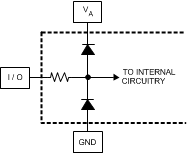JAJSDJ8A April 2017 – October 2021 ADC12D1620QML-SP
PRODUCTION DATA
- 1 特長
- 2 アプリケーション
- 3 概要
- 4 Revision History
- 5 Pin Configuration and Functions
-
6 Specifications
- 6.1 Absolute Maximum Ratings
- 6.2 ESD Ratings
- 6.3 Recommended Operating Conditions
- 6.4 Thermal Information
- 6.5 Converter Electrical Characteristics: Static Converter Characteristics
- 6.6 Converter Electrical Characteristics: Dynamic Converter Characteristics
- 6.7 Converter Electrical Characteristics: Analog Input/Output and Reference Characteristics
- 6.8 Converter Electrical Characteristic: Channel-to-Channel Characteristics
- 6.9 Converter Electrical Characteristics: LVDS CLK Input Characteristics
- 6.10 Electrical Characteristics: AutoSync Feature
- 6.11 Converter Electrical Characteristics: Digital Control and Output Pin Characteristics
- 6.12 Converter Electrical Characteristics: Power Supply Characteristics
- 6.13 Converter Electrical Characteristics: AC Electrical Characteristics
- 6.14 Electrical Characteristics: Delta Parameters
- 6.15 Timing Requirements: Serial Port Interface
- 6.16 Timing Requirements: Calibration
- 6.17 Quality Conformance Inspection
- 6.18 Timing Diagrams
- 6.19 Typical Characteristics
-
7 Detailed Description
- 7.1 Overview
- 7.2 Functional Block Diagram
- 7.3 Feature Description
- 7.4 Device Functional Modes
- 7.5
Programming
- 7.5.1
Control Modes
- 7.5.1.1
Non-ECM
- 7.5.1.1.1 Dual-Edge Sampling Pin (DES)
- 7.5.1.1.2 Non-Demultiplexed Mode Pin (NDM)
- 7.5.1.1.3 Dual Data-Rate Phase Pin (DDRPh)
- 7.5.1.1.4 Calibration Pin (CAL)
- 7.5.1.1.5 Low-Sampling Power-Saving Mode Pin (LSPSM)
- 7.5.1.1.6 Power-Down I-Channel Pin (PDI)
- 7.5.1.1.7 Power-Down Q-Channel Pin (PDQ)
- 7.5.1.1.8 Test-Pattern Mode Pin (TPM)
- 7.5.1.1.9 Full-Scale Input-Range Pin (FSR)
- 7.5.1.1.10 AC- or DC-Coupled Mode Pin (VCMO)
- 7.5.1.1.11 LVDS Output Common-Mode Pin (VBG)
- 7.5.1.2 Extended Control Mode
- 7.5.1.1
Non-ECM
- 7.5.1
Control Modes
- 7.6 Register Maps
- 8 Application Information Disclaimer
- 9 Power Supply Recommendations
- 10Layout
- 11Device and Documentation Support
- 12Mechanical, Packaging, and Orderable Information
パッケージ・オプション
デバイスごとのパッケージ図は、PDF版データシートをご参照ください。
メカニカル・データ(パッケージ|ピン)
- FVA|256
- NAA|376
サーマルパッド・メカニカル・データ
発注情報
6.15 Timing Requirements: Serial Port Interface
over operating free-air temperature range (unless otherwise
noted)The following specifications apply after calibration for
VA = VDR = VTC = VE = 1.9 V;
I and Q channels AC-coupled, FSR pin = High; CL = 10 pF;
differential AC-coupled sine wave input clock, fCLK = 1.6 GHz at
0.5 VP-P with 50% duty cycle; VBG = floating;
non-extended control mode; Rext = Rtrim = 3300 Ω ±0.1%; analog signal source
impedance = 100-Ω differential; 1:2 demultiplex non-DES mode; I and Q
channels; duty-cycle stabilizer on.(1)(2)
| PARAMETER | TEST CONDITIONS | SUB-GROUPS | MIN | NOM(2) | MAX | UNIT | |
|---|---|---|---|---|---|---|---|
| fSCLK (max) | Maximum serial clock frequency | See(3) | 15 | MHz | |||
| fSCLK (min) | Minimum serial clock frequency | See(3) | 0 | MHz | |||
| Serial clock low time | [9, 10, 11] | 30 | ns | ||||
| Serial clock high time | [9, 10, 11] | 30 | ns | ||||
| tSSU | Serial data to serial clock rising setup time | See(3) | 2.5 | ns | |||
| tSH | Serial data to serial clock rising hold time | See(3) | 1 | ns | |||
| tSCS | SCS to serial clock rising setup time | 2.5 | ns | ||||
| tHCS | SCS to serial clock falling hold time | 1.5 | ns | ||||
| tBSU | Bus turnaround time | 10 | ns | ||||
(1) The analog inputs are protected as shown below. Input voltage
magnitudes beyond the Section 6.1 may damage this device.


(2) Typical figures are at TA = 25°C, and represent most
likely parametric norms. Test limits are ensured to Texas Instrument's average
outgoing quality level (AOQL).
(3) This parameter is specified by design and/or characterization
and is not tested in production.